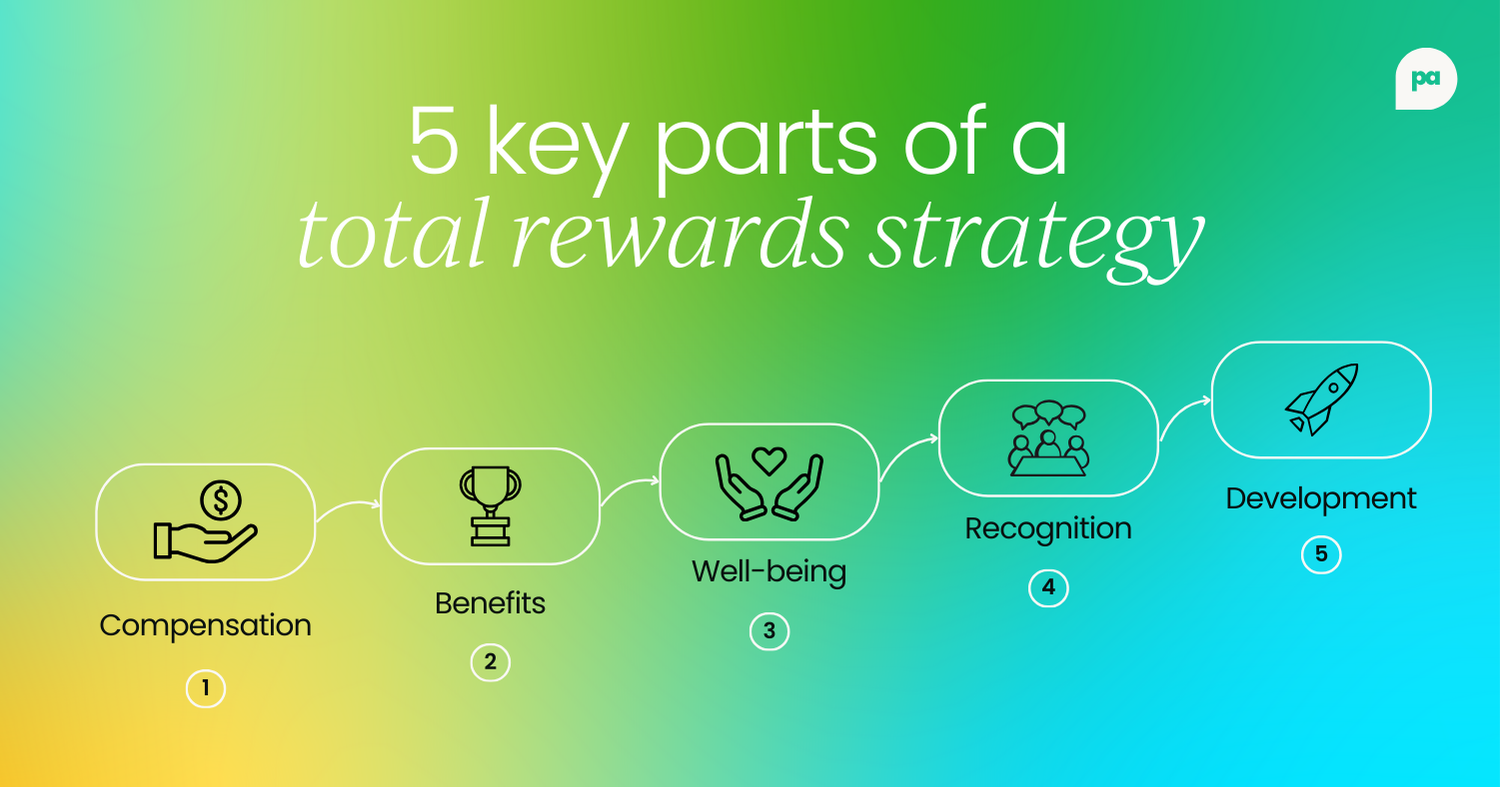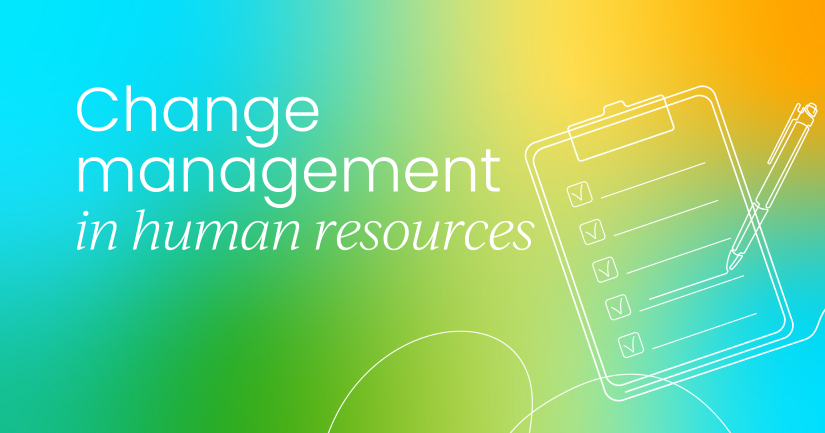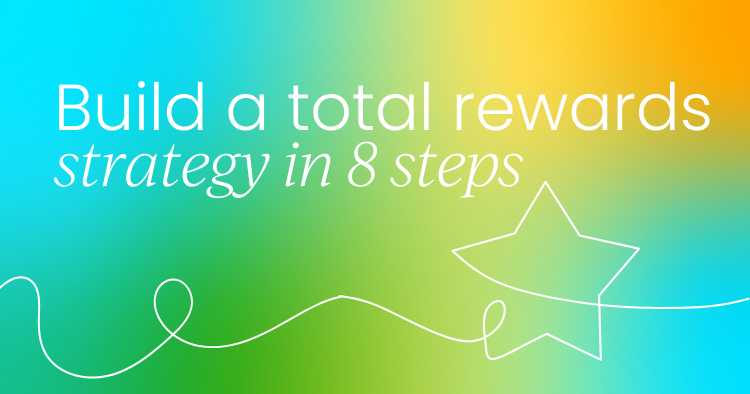Want your team to stay longer, work harder, and feel happier? That’s where a total rewards strategy comes in. It’s the mix of pay, benefits, growth, and culture that keeps employees engaged, motivated, and sticking around for the long haul.
When done right, total rewards make your workplace stand out, attract top talent, and keep your team happy and thriving.
Keep reading as we break down what total rewards really mean, why they matter, the five key parts that make them work, and how to build a strategy your people will love.
What is a total rewards strategy?
A total rewards strategy is the plan for everything you offer employees in exchange for their work and commitment. Yes, salary is part of it, but it’s only one piece. Benefits, career growth, recognition, work-life balance, and a positive culture all play a role.
Rather than focusing solely on base pay, a total rewards strategy integrates all the investments and offerings a company provides to its workforce, which employees value as part of their employee experience.
Why use total rewards strategies?
Despite what many people might think, pay alone often isn’t enough to attract or keep great people. Employees want to feel valued in many ways, and total rewards help deliver that.
For companies, a well-designed total rewards strategy can:
- Increase employee engagement and satisfaction.
- Enhance retention and reduce turnover by offering a competitive employee value proposition.
- Motivate better performance and productivity.
- Align the workforce with business objectives and culture.
- Give employees a voice and choice regarding their rewards, promoting transparency and trust.
For HR and people leaders, total rewards are a powerful lever. You’re not just filling roles, you’re shaping the employee experience.
5 key parts of a total rewards strategy
A great total rewards strategy blends different elements to meet the needs of your team and business. By focusing on these five key areas, you can create a workplace where people feel supported, motivated, and engaged.

1. Compensation
Compensation is the cornerstone of any rewards strategy. It includes the basics like competitive base pay, but also bonuses, commissions, and other incentives that ensure employees feel fairly rewarded for their skills and hard work. When pay is transparent and in line with market standards, it builds trust and shows employees they're valued.
2. Benefits
Think of benefits as the safety net that supports employees' lives outside of work. This includes crucial elements like health coverage, retirement plans, and paid leave. Offering well-rounded benefits (such as childcare assistance or commuter perks) reduces employee stress and makes it easier for them to focus on doing their best work.
3. Well-being
Well-being is all about helping people stay healthy, balanced, and energized. This goes beyond physical health and includes mental and emotional support. By offering flexible schedules, mental health resources, and wellness stipends, you create an environment where employees can truly thrive.
4. Recognition
Recognition is a powerful way to acknowledge hard work and celebrate achievements. It can be a formal award or a simple, genuine shout-out in a team meeting. Regular and meaningful recognition boosts morale, strengthens connections, and shows employees that their efforts don't go unnoticed.
5. Development
Development gives employees a path to grow and learn. Through training programs, mentorship, and clear career paths, you not only help people build new skills but also give them a sense of purpose and progress. Investing in your employees' growth ultimately strengthens your entire organization.

How to create a total rewards strategy
Building an effective total rewards strategy is about being intentional and listening closely to both your people and your business needs. Here’s a step-by-step approach:
1. Review what’s already in place
Before you can build a new strategy, you need to understand what you're working with. Think of this as a complete audit of your current offerings. You're not just checking boxes though, use this time to figure out what's working, what's not, and where the opportunities are.
Start by taking a close look at everything you currently offer. This includes your pay structures, benefits packages, well-being initiatives, recognition programs, and professional development opportunities.
Next, dig into the details. Ask questions like:
- Are employees actually using the programs and perks you offer?
- Do you have a great benefit that no one seems to know about or use?
- How do these offerings align with what your competitors are doing?
- What does your employee feedback and sentiment tell you about what people value most?
This comprehensive review will give you a clear, honest picture of your starting point. You'll be able to identify your strengths to build on and find the gaps you need to fill to create a more effective total rewards strategy.
2. Gather employee input
If you want to create a package that employees will truly value, the best way to do it is by listening to them.
Don't just rely on assumptions. Actively seek out what your employees want and need. You can do this through:
- Anonymous surveys to get honest feedback on what's working and what's not.
- Focus groups to have more in-depth conversations about specific areas, like benefits or well-being.
- One-on-one conversations during performance reviews or informal check-ins.
Remember that a one-size-fits-all approach rarely works. The priorities of a recent graduate may be very different from those of a parent or a long-tenured employee.
By considering different life stages and roles, you can create a rewards package that truly resonates with a diverse workforce. This step ensures your strategy is built on real needs, not just what you think people want.

3. Involve leaders early
A total rewards strategy won't succeed without strong support from the top. Think of your leaders as the champions of this new approach. When managers and executives are fully on board, they'll not only advocate for the strategy but also model the desired behaviors, making it much more likely that employees will embrace it.
Engage your leaders early in the process. They have unique insights into what their teams need and what motivates them. By involving them from the beginning, you ensure they see the strategy as a valuable business tool, not just another HR initiative. Their buy-in will help embed the new strategy into your company's culture, turning it into a core part of how you do business.
4. Set clear goals and priorities
With a clear understanding of your current situation and employee needs, it's time to define your goals. Being specific here is crucial because it's what makes your strategy focused, measurable, and effective.
Ask yourself what you're trying to achieve. Are you looking to:
- Attract top talent in a competitive market?
- Improve employee retention and reduce turnover?
- Boost engagement and morale across the company?
These specific goals will serve as your roadmap. They will guide every decision you make, from adjusting compensation to adding new well-being benefits. By defining these priorities upfront, you'll have a clear way to measure the success of your strategy down the line and make adjustments as needed.
5. Align with your culture and values
Your total rewards strategy needs to feel authentic to your organization. It shouldn't be a generic plan copied from another company, but a direct reflection of your culture and core values. When your rewards align with what you stand for, they reinforce your brand and make the company a more desirable place to work.
For example, a company that highly values innovation might offer rewards like flexible time for employees to work on personal projects or a budget for creative workshops and learning. On the other hand, an organization with a people-first culture might invest more heavily in comprehensive mental health support, generous paid leave, and flexible work arrangements.
This alignment ensures your rewards aren't just a list of perks, but a genuine extension of who you are as a company. This authenticity strengthens your employer brand and helps you attract and retain people who share your values.
6. Create a balanced, flexible mix
Now that you have your goals and values in place, it’s time to build a cohesive strategy. The most effective total rewards plan isn't a one-size-fits-all solution; it's a balanced blend of all five components - compensation, benefits, well-being, recognition, and development.
The key here is flexibility. A truly inclusive strategy recognizes that your employees have diverse needs, and what's valuable to one person might not be to another. For example, a young professional might prioritize development and mentorship, while a parent might value flexible work hours and robust health benefits.
Consider offering a "menu" of benefits or a flexible stipend that allows employees to choose what matters most to them. This adaptability helps you attract and retain talent across all career stages and ensures your investment in rewards is truly meeting the needs of your entire workforce.
7. Communicate clearly and often
The best total rewards strategy in the world won't be effective if employees don't know it exists. Your goal is to make sure every single employee understands what's available to them and how to use it. This transparency is what drives engagement and ensures your investment pays off.
When you roll out your strategy, use simple, straightforward language. Avoid jargon and complicated explanations. Instead, focus on real-life examples of how different programs can benefit your team.
Make communication a regular habit, not a one-time announcement. Reinforce the message in:
- Onboarding materials for new hires.
- Regular team meetings and company-wide updates.
- Internal newsletters and resource pages.
By communicating clearly and consistently, you ensure your total rewards package is understood, appreciated, and ultimately, used to its full potential.
8. Track and measure results
Your work doesn't end once the strategy is launched. To ensure it remains effective, you need to continuously track and measure its impact. Think of this as a feedback loop that helps you fine-tune your approach over time.
Look at key metrics to see if your strategy is meeting the goals you set in step 4. Some important data points include:
- Retention rates and turnover numbers.
- Employee engagement scores and feedback from surveys.
- Participation and usage data for benefits and wellness programs.
- Recruitment metrics, such as time-to-hire and candidate quality.
By regularly analyzing these insights, you can identify what’s working and what's not. This data-driven approach allows you to make informed decisions and adjust your offerings to keep them relevant, competitive, and truly valuable to your employees.
When you follow all these steps, your total rewards strategy becomes more than just a list of perks. It evolves into a core part of your employee experience and a key reason why people choose to join and stay with your company.
FAQs
Q. What are the benefits of a total rewards strategy?
A. The benefits of a total rewards strategy include attracting top talent, improving retention, boosting employee engagement, and aligning rewards with company culture and values.
Q. What are some total rewards strategy examples?
A. Examples of total rewards strategies include offering competitive salaries, flexible benefits plans, wellness programs, public recognition, training budgets, mentorship programs, and clear career advancement paths.
Q. What is the purpose of total rewards?
A. The purpose of total rewards is to provide a fair, motivating, and holistic package that meets employee needs, supports performance, and reinforces company culture.
Q. What are the best employee rewards strategies to increase employee retention?
A. The best employee rewards strategies for retention combine competitive pay, personalized benefits, regular recognition, professional growth opportunities, and a positive work environment.
Q. How do total rewards impact employee engagement?
A. Total rewards impact employee engagement by showing employees they are valued, supporting their career growth, and meeting their personal and professional needs—leading to higher motivation and performance.
Q. How often should a total rewards strategy be reviewed?
A. A total rewards strategy should be reviewed at least once a year, or more frequently if there are major changes in the business, job market, or employee needs.
Ready to level up your people strategy?
If you’re ready to take your HR strategies to the next level, why not join the thousands of HR and people professionals who trust People Alliance as their go-to resource?
With a free Insider membership, you’ll get:
- Expert insights – battle-tested templates and frameworks for your biggest HR challenges
- Ready-to-use tools – solve problems faster with the collective know-how of our community
- Peer connections – exchange ideas with people leaders around the globe
- Real-world cases – hours of insights from Fortune 500 companies and exciting startups
- Exclusive content – in-depth guides and articles from world-class people teams
- Industry events – free access to expert-led events and networking opportunities
As an Insider, you’re not just signing up - you’re stepping into a community where expertise meets innovation. Your next career breakthrough starts here.



 Follow us on LinkedIn
Follow us on LinkedIn


